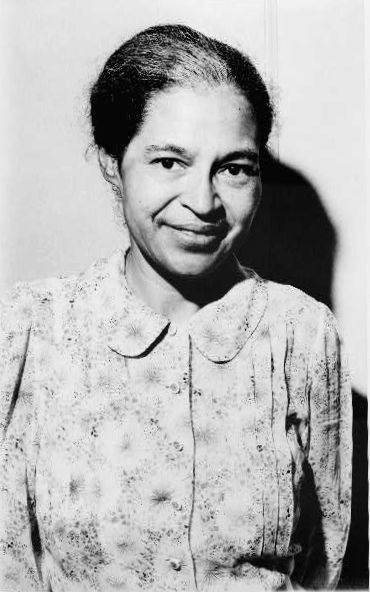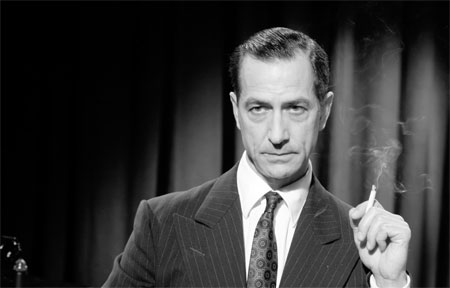According to National Security Agency historian Robert Hanyok, his recent work outlining a deliberate NSA cover-up following the Gulf of Tonkin incident has been suppressed by the agency since 2001, in part because of Weaponsgate. “He said N.S.A. historians began pushing for public release in 2002, after Mr. Hanyok included his Tonkin Gulf findings in a 400-page, in-house history of the agency and Vietnam called ‘Spartans in Darkness.’ Though superiors initially expressed support for releasing it, the idea lost momentum as Iraq intelligence was being called into question, the official said.“
Category: History
Last stop.



“Memories of our lives, of our works and our deeds will continue in others.“
R.I.P Rosa Parks 1913-2005.”
Or is it Bucky?
Two Fresno climbers discover a frozen WWII pilot on a Sierra Nevada glacier. As a friend of mine pointed out, this could be terrible news for the Red Skull…
In My Secret Life.
By the way, since people often ask me about it, and since I’ve been working on grant writing of late anyway, I’ve written up and html’ized a brief executive summary of my dissertation project. As always, subject to change…particularly the title. (Left-of-the-Colon probably isn’t the best place for a The The pun.)
Feet of Clay?
“The blend of businessmen’s aversion to government regulation, down-home cultural populism and Christian moralism that sustains today’s Republican Party is a venerable if loosely knit philosophy of government dating back to long before the right-wing upsurge that prepared the way for Reagan’s presidency…Insofar as perennial themes shape our politics, it is remarkable how so many of contemporary conservatism’s central ideas and slogans renovate old Whig appeals.“
By way of Cliopatria, historian Sean Wilentz compares today’s GOP to the Whig Party of the 1830’s and ’40s. Food for thought, but, as Wilentz himself admits, the general lack of state power back then — and, more importantly, the absence of corporate consolidation in the antebellum era — significantly changes the rules of the game. While laissez-faire policies more likely meant increased competition and economic growth in the 19th century, it means something else entirely in today’s world, when long-standing, fully-formed corporate behemoths are ready and willing to fill any power vacuum left by less government regulation. (That’s why the Gilded Age analogy, I think, still makes more sense — It’s business cronyism, and not economic competition, that drives Dubya republicanism.) Update: Via The Late Adopter, Eric Foner, the centerpiece of a weekend conference around these parts, reviews Wilentz’s new tome in The Nation.
Stone’s Last Stand.
After the atrocious Alexander, Oliver Stone returns to American history for inspiration with Son of the Morning Star, based on the 1997 book by Evan S. Connell about George A. Custer and Little Bighorn. Ok, but I still want to see Stone’s take on LBJ some day, just to complete the trifecta.
Two Sides to Every Story.
Here’s some interesting news: Clint Eastwood is coming out with two films about the Battle of Iwo Jima simultaneously next year, Flags of our Fathers (the US perspective) and Lamps Before the Wind (from the Japanese viewpoint.) “Typically, Eastwood is not able to articulate fully his rationale for this ambitious enterprise: ‘I don’t know — sometimes you get a feeling about something. You have a premonition that you can get something decent out of it,’ he says. ‘You just have to trust your gut.’” Well, that and your sources.
The Once and Future Quake.
“Earth, that living, seething, often inhospitable and not altogether intelligently designed thing, has again shrugged, and tens of thousands of Pakistanis are dead…Americans reeling from Hurricane Katrina, and warned of scores of millions of potential deaths from avian flu, have a vague feeling — never mind the disturbing rest of the news — of pervasive menace from things out of control. Too vague, according to Simon Winchester.” In light of the horrifying calamity in Pakistan this past weekend (as well as Katrina and the tsunami), George Will peruses Simon Winchester’s new book on the San Francisco earthquake of 1906.
Exhuming McCarthy.

While perhaps a bit too black-and-white in terms of the history, George Clooney’s Good Night, and Good Luck is nevertheless a somber and captivating paean to Edward R. Murrow, his televised expose of Joe McCarthy, and, by extension, the Pioneer Days of Television Journalism. (In this last regard, it’s somewhat reminiscent of the excellent Clooney-produced live TV version of Fail Safe a few years ago.) It’s also assuredly a smoother, subtler, and more accomplished bit of muckraking than, say, Tim Robbins’ recent and lamentably over-the-top Embedded. Once again displaying the surprisingly strong directorial sense he exhibited in Confessions of a Dangerous Mind, Clooney also benefits here from a smartly written script which refuses to talk down to its audience, the crisp black-and-white cinematography, and quality performances across the board. As a result, what could have been an above-average History Channel documentary is instead a powerful and intelligent work of cinema that’s easily one of the better films out this year.
Admittedly, as Jack Shafer pointed out in Slate, Good Night, and Good Luck is rather narrowly focused, and works better as an impassioned and articulate morality play than it does as sound history. The Murrow of this film is saintly to a fault (although David Straitharn ameliorates this with a sardonic and multifaceted performance that may well get some nods come award time.) And there’s very little historical context offered herein, either for the origins of the McCarthy hysteria or for the Wisconsin Senator’s ultimate downfall, which had more to do with picking a fight with the army than with the Murrow broadcast.
That being said, I really like the way Clooney uses archival footage in this film. For one, Clooney was clever to follow Murrow’s example and let Joe McCarthy hoist himself on his own petard. Having the real McCarthy excoriate Murrow as the “leader of the jackal pack” gives the film a sense of history (and menace) that an actorly turn couldn’t have provided. For another, Clooney, who definitely appears to have done his homework, is unafraid to cut to real historical footage — the Annie Lee Moss hearings, for example — for extended periods, and just let the inherent drama of the real proceedings speak for itself. As a result, the history feels alive and contemporary, no mean feat when so many other historical films seem to use the past as merely exotic window dressing. Could the film have been more nuanced in its appraisal of both Murrow and McCarthyism? Undoubtedly. (Then again, nuanced appraisals weren’t exactly McCarthy’s strong point, either., nor is it a long suit of his current defenders.) But on the whole, Good Night, and Good Luck is, I think, a worthy exercise in historical filmmaking, and one with some obvious relevance in light of today’s entertainment-addled, sideshow-obsessed news media.
Movie-wise, there are a few small problems. I think the GN, & GL should have done either more or less with Robert Downey, Jr. and Patricia Clarkson as Wershbas Joe and Shirley — their particular plight doesn’t tie in to the rest of the story very well. And, while Ray Wise is good as the broadcaster-at-wits-end Don Hollenbeck, he’s also typecast in my mind — I kept expecting him to break into the Leland Palmer dance. All in all, though, Good Night, and Good Luck manages to enliven both the staid television studios of Fifties CBS and this historical moment with smoky jazz, languishing cigarettes, and ominous shadows. As the show says, see it now.
Gervais Whisper.
So that‘s why David Brent grooves so remarkably well…apparently, Ricky Gervais of The Office and Extras was in a New Wave band called Seona Dancing. I must say, he looks very Spandau Ballet…but at least he didn’t get stuck with the grotesque ’80s hair. (Via Quiddity.)
